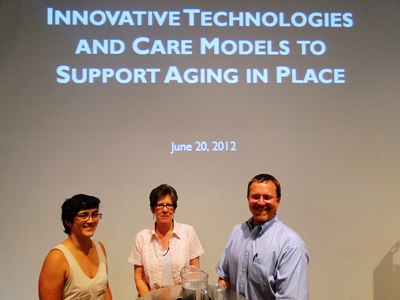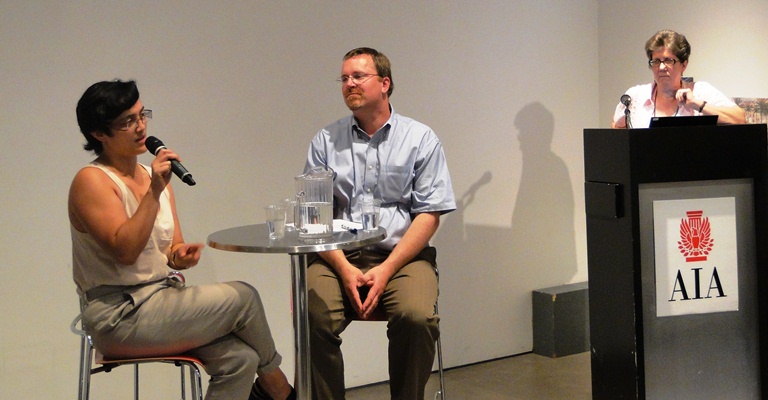by: admin

(l-r) Cheryl Gladstone, David Dring, and Christine Hunter, AIA, discussed technological innovations to accommodate aging in place.
Daniel Fox
Event: Innovative Technologies and Care Models to Support Aging in Place
Location: Center for Architecture, 6.20.12
Speakers: David Dring, Administrator of Technology Services, Selfhelp Community Services; Cheryl Gladstone, Program Director for Senior Housing, Enterprise Community Partners
Moderator: Christine Hunter, AIA, Principal, Magnusson Architecture and Planning
Organizer: AIANY Design for Aging Committee
“We are facing an aging tsunami and we are not prepared,” stated David Dring of Selfhelp Community Services. Enterprise Community Partners’ Cheryl Gladstone elaborated by explaining that within the next half-century the population over age 65 will be the largest ever. And that cohort is increasing much more rapidly than any other age group. This is a significant shift in demographics, a virtual reversal of the traditional pattern in which younger age groups have always outnumbered seniors.
Enterprise Community Partners and Selfhelp Community Services are two organizations devoting major efforts to preparing for this phenomenon. Gladstone posited that the most satisfactory and predominant long-term care approach for the future is likely to be aging in place, in housing where seniors are already living, often for decades. This is the situation generally preferred by seniors, but for it to be broadly successful, integration of services is essential.
Retrofitting existing housing to permit seniors to remain independent is one of the greatest challenges. In addition to physical modifications, provision of services that allow and encourage seniors to maintain contact with their families and healthcare providers is critical. Isolation of seniors within their homes is one of the most significant contributors to deteriorating health. Enterprise is sponsoring numerous initiatives to develop improved ways of providing services, including an effort to establish statewide programs of coordination between housing developers and healthcare providers, and establishing connections between architects and developers of senior housing. Through grants and workshops, the organization conducts research and provides funding for innovative projects that aim to integrate services and improve living conditions for seniors. Among the strategies included are green retrofits, universal design, housing as hub of living, advanced technology, isolation prevention, in-home healthcare delivery, self-management of disease, and various financing mechanisms. Gladstone referred to a variety of types of senior living communities and services that can support aging in place, including co-housing, Naturally Occurring Retirement Communities (NORCs), village models, affordable assisted living, Programs of All-Inclusive Care for the Elderly (PACE), and GreenHouses.
Selfhelp has established Virtual Senior Centers (VSCs), engaging seniors through the use of computer technology that allows them to interact with other seniors, participate in learning-center classes, and maintain contact with their families without leaving their homes. Interactive communication with healthcare providers also becomes possible, along with motion sensors in the home to monitor seniors’ behavior and alert caregivers to irregularities that might indicate health or safety problems. These also enable seniors to make their conditions known to caregivers when problems occur. Dring spoke about a similar approach used in Selfhelp’s telehealth kiosk project, which focuses on health literacy by providing information that improves seniors’ ability to self-monitor their own physical conditions. Interactive computer monitors are placed in convenient locations such as building lobbies or other community gathering places, and provide information on nutrition, taking blood pressure, and other relevant topics. These social support approaches not only have the effect of empowering seniors through interaction with their communities, they also improve the overall health and quality-of-life, and significantly reduce major health care costs.
Social support systems focus on preventive methods of healthcare, rather than waiting for accidents/illness to occur and treating them afterwards. Careful design of the physical aspects of seniors’ homes can reinforce the effectiveness of these services. Research has indicated that particular areas of the home are more prone to cause problems than others, such as bathrooms, elevators, and corridors. Architects need to increase their awareness of these issues in order to fully contribute toward improving seniors’ quality-of-life.
Jerry Maltz, AIA, is Co-Chair of the AIANY Design for Aging Committee.










